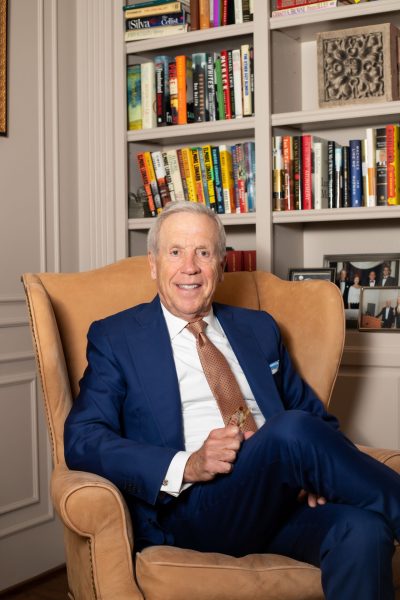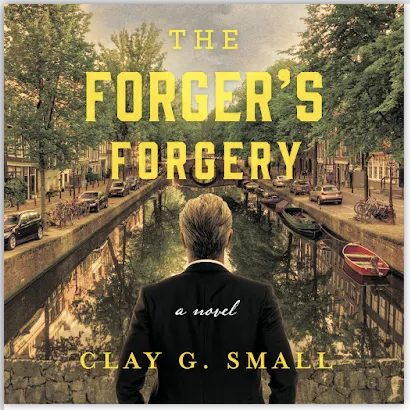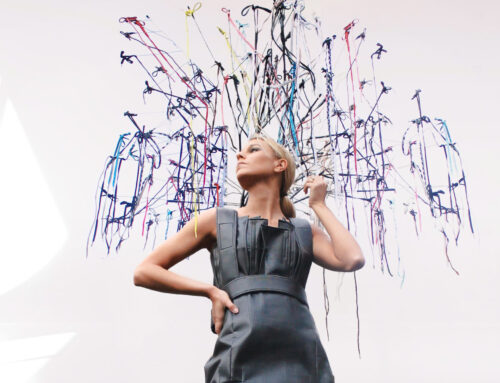
Photography by Jessica Turner.
Neighbor Clay G. Small grew up in and around New York City, before heading to Ohio Wesleyan University to play soccer. A two-time all-American player, he was drafted by the Dallas Tornado, a professional soccer team in the Dallas area from 1967-1981. After being released by the Tornado, team owner Lamar Hunt encouraged him to enroll at Southern Methodist University’s law school. Later, Small moved back to Manhattan, where he worked on Wall Street for five years before starting a 30-year career at PepsiCo as general counsel for many of the company’s divisions. Small left the corporate world to become a professor at SMU’s Cox School of Business and a visiting professor at Vrije Universiteit Amsterdam. His sophomore novel, The Forger’s Forgery, featuring Henry Lindon takes place in Dallas, the city he calls home, and Amsterdam, the city he loves.
Why did you transition into authoring books?
I always had this thought that at some point in my life, I would become a writer. And I proceeded to procrastinate for years. And when I was at my job at PepsiCo, I was general counsel of Pizza Hut. In that job, I became friends with the general counsel of McDonald’s. Over dinner, he told me how his novel was about to be published. He said “any lawyer worth his salt has at least one novel in his life.” I was 36 years old. That stuck with me for all those years. And when I started teaching at the Cox School, I found what I thought was a different take — to write a novel as someone who was in academia without being an academic.
How did you decide on the topic for your first book, Heels over Head?
I got a phone call from a friend of mine, who’s a lobbyist in Washington, D.C.
And he says: ‘Hey, I did it. I got it.”
I go: “What did you do?”
He goes: “Well, you’re near your computer?”
I go: “Yeah, I’m sitting in front of one.”
He says: “I’ll send you a photo.”
It’s his forearm, where it is tattooed with “I wear the chains I made in life, but forged them link by link.” And around it was a slave chain that went all the way around his arm. And I started thinking about this. I have two brothers, one of whom is capable of doing something similar. I started to think about it, what would my reaction be if my brother had made this call. And that weekend, that subject matter became the first 50 pages of the book.
How did you feel after writing that first book?
In some ways, terrific. In some ways, very humbled. I had a great editor. After I sent her the completed book, she sent me back her first edit, which deleted 50 pages of the book that I thought were just terrific.
What’s your favorite part of the writing process?
You know, as the Supreme Court Justice Hugo Black famously said: “There’s no such thing as good writing, only good rewriting.” And to me, I love the process of thinking I completed a chapter and going back and realizing how it could be significantly improved. And that process of editing my own work is something that I do enjoy.

What’s the inspiration behind your second book, The Forger’s Forgery?
The second book is my love affair with Amsterdam for the last 25 years. Let me tell you the story about how that started. When I first was assigned responsibility for all the European PepsiCo legal functions, I had a meeting of everybody in London. And when I got the bill, it was basically more than half of my travel and expense budget. And a friend of mine, a Dutch attorney, said: “Why don’t you just have the next meeting in Amsterdam? It’s less than half the price, and everyone speaks English.” The next year, we had the meeting in Amsterdam. I’ve been to Amsterdam now 22 times. It started off as a financial decision. And when I was there, I went to the Rijks Museum and saw three incredible paintings by Vermeer. And I decided that one of my life goals would be to see every (Johannes) Vermeer in existence. There’s only 36 of them, and I’ve seen 33. One, of course, was stolen out of a museum in Boston, so I won’t get to see that. But that in turn led me to be in Amsterdam, eating pancakes as always. One morning, I was reading that in Rotterdam there was an exhibit of forgeries by a man named Han van Meegeren, a Vermeer forger. And I said to myself: “Why would there be an exhibit of a forgery?” And I went to Rotterdam to see it and was amazed by the exhibit. Frankly, I was amazed how poor the Vermeer forgeries were. And I became interested in how in the world this man pulled off this incredible fraud. And that became the center of the novel.
Did you have a lot of knowledge about art forgery before the second book?
I would say that number is zero. I bought a bunch of books. I read an awful lot of articles. The talk I give basically revolves around how forgers are treated in the court of public opinion. They’re not treated like the criminals that they are. They’re treated like some kind of schoolboys caught in some kind of sophomore tomfoolery; these individuals go from being despised to being held very high in society and making a fortune selling their art now under their own names.
Plans for a third book?
I’m thinking about it. And what I would really like to try to do is write a book in a woman’s voice.
Would it be a spinoff of your first two books?
As I’m thinking about it now, it would be something of a spinoff because it would be in the voice of a character named Bernadette Gordon, who is an art professor in Amsterdam. And I want to see, I’m not sure I can do this, but if I can write in the voice of a woman.
Why does that intrigue you?
I’ve never tried it. And I think women are more prone to read books than men. I think the buying public for books is predominantly female. And I’d like to give it a shot.
Is Henry Lindon based on you?
As Agatha Christie says, most fiction is autobiographical, and all autobiographies are fiction. In my case, where I go is where Henry ends up going. So the first book, it was Mexico City and Buenos Aires, and this book, it was Amsterdam.
Was there any point when you were “stuck” as part of the writing process?
Each book has taken me four years to complete, from start to finish. When I say start to finish, I mean, when I started to write to when it’s published. I envy those who do have a strict writing schedule. For me, I can sit for five and six hours at a time, if I get an idea. And if I don’t have an idea, I can’t force myself to sit there in front of the computer. I just can’t do it.
Have you always had this interest in art, even before Amsterdam?
Yes. When I was in college, I was an English literature major. But I took a course called art appreciation. And I was probably 19, 20 years old. And that kind of kicked off my lifelong interest in art.






